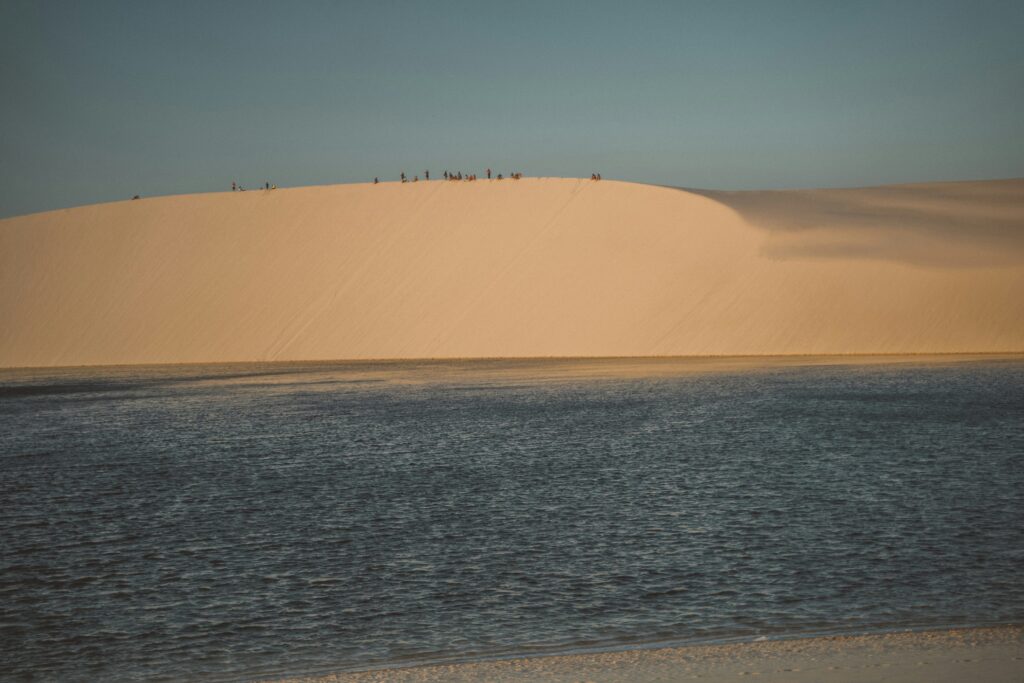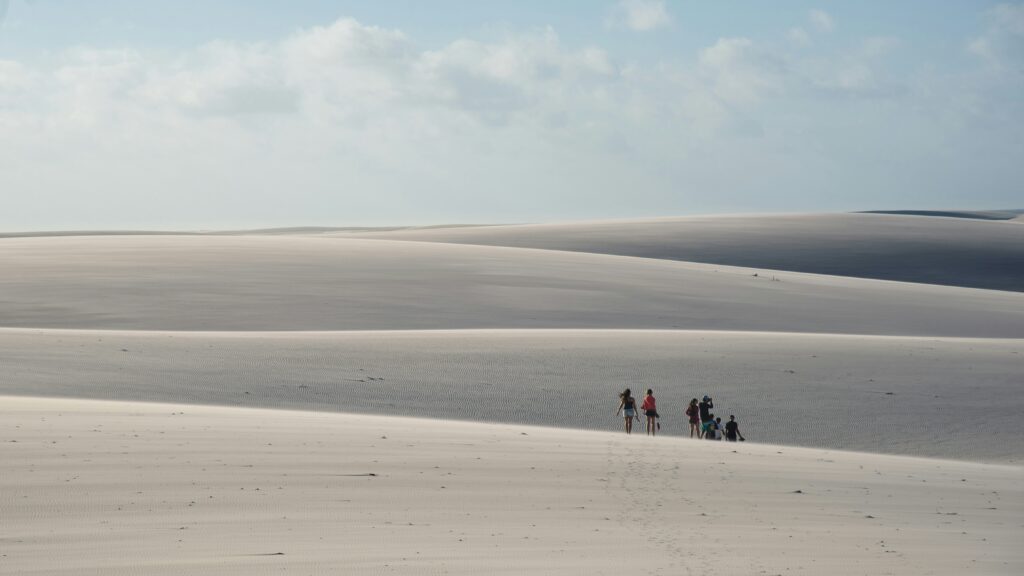Nestled in the northeastern state of Maranhão, Brazil, lies one of Mother Nature’s most striking spectacles – Lençóis Maranhenses National Park. This surreal landscape is a labyrinth of undulating white sand dunes interspersed with crystal-clear freshwater lagoons, painted against the backdrop of an azure sky. Often described as a desert paradise, Lençóis Maranhenses transcends conventional definitions and showcases an unparalleled blend of stark beauty and ethereal wonder.

The Geology and Grandeur
Lençóis Maranhenses spans an expansive 1,550 square kilometers and resembles a vast bedsheet (hence its name ‘Lençóis,’ meaning ‘sheets’ in Portuguese) billowing in the wind. The park’s topography is dominated by sweeping, crescent-shaped sand dunes which rise up to 40 meters high. Although it may seem like a classic desert at first glance, Lençóis Maranhenses receives an annual rainfall of approximately 1,200 millimeters, distinguishing it from true desert regions. This annual deluge fills the interdunal valleys with rainwater, forming countless lagoons that dot the grained landscape.
The Ethereal Lagoons
These lagoons, the crowning jewels of the park, emerge as rainwater collects in the valleys between the sand dunes during the rainy season, which spans from January to June. The water pooled in these natural basins creates lagoons that range in color from emerald green to brilliant turquoise, sparkling under the tropical sunlight. Notable lagoons such as Lagoa Azul (Blue Lagoon) and Lagoa Bonita (Beautiful Lagoon) are among the most famous, drawing visitors from around the globe.
The ephemeral nature of these lagoons adds to the park’s mystique. The lagoons typically reach their peak in July and August, when the water is at its deepest and the azure pools most vibrant. By the end of the dry season, many of these lagoons evaporate, leaving behind only traces of their aquatic splendor until the next rainy season beckons their return.
Flora and Fauna
Despite its seemingly inhospitable environment, Lençóis Maranhenses is teeming with life. The park’s flora is sparse yet resilient, comprising mainly of vegetation that has adapted to the shifting sands, such as grasses and shrubs. Mangroves and buriti palms thrive in areas where subterranean water is available.
More:Read about on Vibrant Capital of Colombia Bogotá
The lagoons and surrounding areas harbor a surprising array of fauna, from fish and crustaceans to larger predators and bird species. One remarkable adaptation is seen in the small fish known locally as “trairão” (a type of wolf fish) and “cascudo” (a type of armored catfish), which survive the intermittent drying of lagoons by burrowing into the wet sand or mud, entering a state of dormancy until the rains return. Migratory birds, such as sandpipers, plovers, and herons, are frequently spotted in the wetlands, while the diverse ecosystems at the edge of the park support capybaras, deer, and even elusive jaguars.
Human Connection
The human touch is lightly woven into the fabric of Lençóis Maranhenses. The native Caboclo people, descendants of Indigenous tribes and Portuguese settlers, have lived in harmony with this unique environment for generations. Their traditional, sustainable ways of fishing and gathering reflect a deep understanding of the natural rhythms of the park. Small, rustic communities like Atins, Santo Amaro, and Barreirinhas serve as gateways to the park, offering warm hospitality and intimate insights into local culture.

Barreirinhas, the most accessible town, functions as the primary launch point for exploring Lençóis Maranhenses. From here, adventurous travelers can embark on guided tours, trekking adventures, or exhilarating 4×4 excursions across the dunes. Despite the growing interest in this natural wonder, efforts are being made to balance tourism with conservation, ensuring that the pristine beauty of the park endures.
Ecotourism and Sustainability
In recent years, Lençóis Maranhenses has garnered attention as a premier ecotourism destination. This recognition comes with the responsibility of preserving its fragile ecosystems. Sustainable tourism initiatives focus on minimizing environmental impact, educating visitors, and promoting local economic development. Activities like kayaking in the lagoons, observing the rich biodiversity, and guided eco-tours foster a connection between visitors and the natural world, encouraging a respect for this delicate environment.
The Magic of Visit
Experiencing Lençóis Maranhenses is a feast for the senses. The adventure begins with the journey itself – navigating the rugged terrain by 4×4 or kayaking through the interconnected lagoons to reach the heart of the park. Visitors are greeted by an otherworldly vista where pristine sand meets sky and water in a seamless, shimmering expanse.
Each exploration reveals a new facet of the park’s charm: watching the sunrise paint the dunes in pastel hues, floating in the refreshingly cool waters of a secluded lagoon, or taking in the breathtaking panorama from atop a towering sand crest. The interaction of light and shadow on the landscape creates an ever-changing tapestry that enchants and mesmerizes.
Must Visit:odishashop.com
Conclusion
Lençóis Maranhenses National Park is a captivating testament to the marvels of nature. Its unique convergence of sand dunes and water-filled valleys creates a transient wonderland that continues to inspire awe and reverence. The delicate balance of ecosystems, the interplay of natural forces, and the serene, almost mystical beauty of its landscape make Lençóis Maranhenses not merely a destination, but a profound and transformative experience.

For those fortunate enough to wander its sandy expanses, the memory of Lençóis Maranhenses lingers long after the journey ends, a reminder of the sublime perfection that exists in the natural world, and the enduring power of nature’s artistry.
FAQ For Lençóis Maranhenses, Brazil: The Enchanting Dance of Dunes and Lagoons
What are Lençóis Maranhenses?
Lençóis Maranhenses is a national park in Brazil known for its stunning landscape of white sand dunes and freshwater lagoons.
When is the best time to visit Lençóis Maranhenses?
The best time to visit is during the rainy season, from July to September, when the lagoons are at their fullest and most beautiful.
Are there any activities to do in Lençóis Maranhenses?
Visitors can enjoy activities such as dune walking, swimming in the lagoons, and taking guided tours to explore the park’s unique ecosystem.
Are there accommodations near Lençóis Maranhenses?
There are accommodations available in nearby towns such as Barreirinhas and Atins, offering a range of options from guesthouses to luxury resorts.
Is it safe to visit Lençóis Maranhenses?
Yes, Lençóis Maranhenses is a safe destination for visitors, but it’s always important to take standard precautions and heed advice from local guides.

